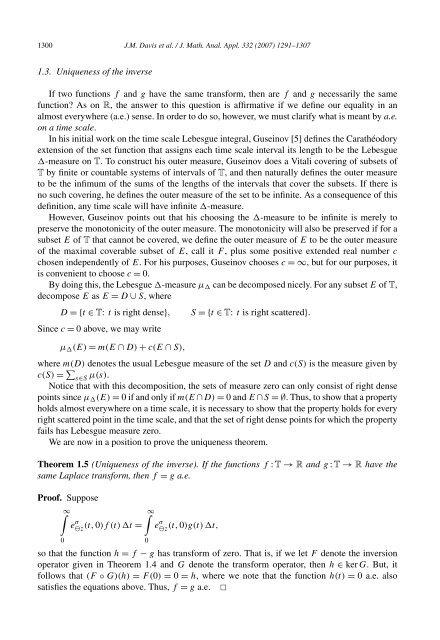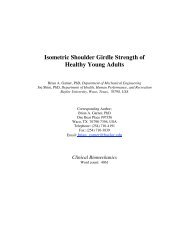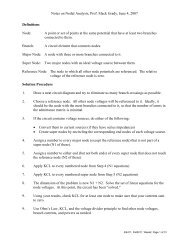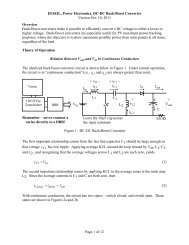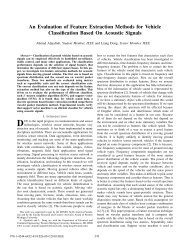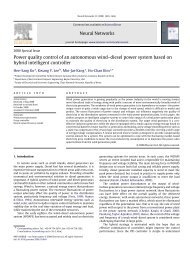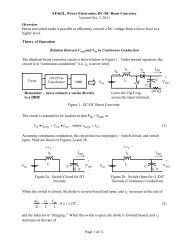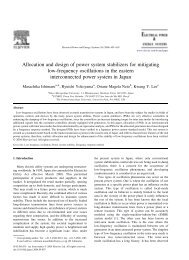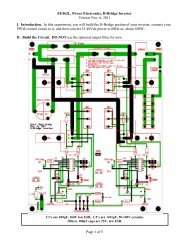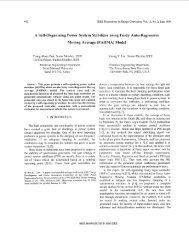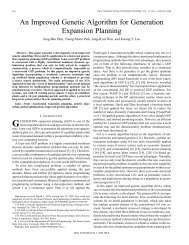The Laplace transform on time scales revisited - ECS - Baylor ...
The Laplace transform on time scales revisited - ECS - Baylor ...
The Laplace transform on time scales revisited - ECS - Baylor ...
Create successful ePaper yourself
Turn your PDF publications into a flip-book with our unique Google optimized e-Paper software.
1300 J.M. Davis et al. / J. Math. Anal. Appl. 332 (2007) 1291–13071.3. Uniqueness of the inverseIf two functi<strong>on</strong>s f and g have the same <str<strong>on</strong>g>transform</str<strong>on</strong>g>, then are f and g necessarily the samefuncti<strong>on</strong>? As <strong>on</strong> R, the answer to this questi<strong>on</strong> is affirmative if we define our equality in analmost everywhere (a.e.) sense. In order to do so, however, we must clarify what is meant by a.e.<strong>on</strong> a <strong>time</strong> scale.In his initial work <strong>on</strong> the <strong>time</strong> scale Lebesgue integral, Guseinov [5] defines the Carathéodoryextensi<strong>on</strong> of the set functi<strong>on</strong> that assigns each <strong>time</strong> scale interval its length to be the Lebesgue-measure <strong>on</strong> T. To c<strong>on</strong>struct his outer measure, Guseinov does a Vitali covering of subsets ofT by finite or countable systems of intervals of T, and then naturally defines the outer measureto be the infimum of the sums of the lengths of the intervals that cover the subsets. If there isno such covering, he defines the outer measure of the set to be infinite. As a c<strong>on</strong>sequence of thisdefiniti<strong>on</strong>, any <strong>time</strong> scale will have infinite -measure.However, Guseinov points out that his choosing the -measure to be infinite is merely topreserve the m<strong>on</strong>ot<strong>on</strong>icity of the outer measure. <str<strong>on</strong>g>The</str<strong>on</strong>g> m<strong>on</strong>ot<strong>on</strong>icity will also be preserved if for asubset E of T that cannot be covered, we define the outer measure of E to be the outer measureof the maximal coverable subset of E, call it F , plus some positive extended real number cchosen independently of E. For his purposes, Guseinov chooses c =∞, but for our purposes, itis c<strong>on</strong>venient to choose c = 0.By doing this, the Lebesgue -measure μ can be decomposed nicely. For any subset E of T,decompose E as E = D ∪ S, whereD ={t ∈ T: t is right dense}, S ={t ∈ T: t is right scattered}.Since c = 0 above, we may writeμ (E) = m(E ∩ D) + c(E ∩ S),where m(D) denotes the usual Lebesgue measure of the set D and c(S) is the measure given byc(S) = ∑ s∈S μ(s).Notice that with this decompositi<strong>on</strong>, the sets of measure zero can <strong>on</strong>ly c<strong>on</strong>sist of right densepoints since μ (E) = 0 if and <strong>on</strong>ly if m(E ∩D) = 0 and E ∩S =∅. Thus, to show that a propertyholds almost everywhere <strong>on</strong> a <strong>time</strong> scale, it is necessary to show that the property holds for everyright scattered point in the <strong>time</strong> scale, and that the set of right dense points for which the propertyfails has Lebesgue measure zero.We are now in a positi<strong>on</strong> to prove the uniqueness theorem.<str<strong>on</strong>g>The</str<strong>on</strong>g>orem 1.5 (Uniqueness of the inverse). If the functi<strong>on</strong>s f : T → R and g : T → R have thesame <str<strong>on</strong>g>Laplace</str<strong>on</strong>g> <str<strong>on</strong>g>transform</str<strong>on</strong>g>, then f = g a.e.Proof. Suppose∫ ∞0∫∞e⊖z σ (t, 0)f (t) t = e⊖z σ (t, 0)g(t) t,0so that the functi<strong>on</strong> h = f − g has <str<strong>on</strong>g>transform</str<strong>on</strong>g> of zero. That is, if we let F denote the inversi<strong>on</strong>operator given in <str<strong>on</strong>g>The</str<strong>on</strong>g>orem 1.4 and G denote the <str<strong>on</strong>g>transform</str<strong>on</strong>g> operator, then h ∈ ker G. But,itfollows that (F ◦ G)(h) = F(0) = 0 = h, where we note that the functi<strong>on</strong> h(t) = 0a.e.alsosatisfies the equati<strong>on</strong>s above. Thus, f = g a.e. ✷


